Abstract
Chloroethylnitrosoureas (CENUs) are alkylating and crosslinking agents used for the treatment of human cancer; they are both mutagenic and carcinogenic. We compared the levels of induction of sister chromatid exchanges (SCEs) and the cytotoxicity of nitrosoureas that alkylate only with CENUs. CENUs are 200-fold more cytotoxic and induce SCEs with 45-fold greater efficiency than agents that do not crosslink; therefore, crosslinking is probably the most important molecular event that leads to cell death and induction of SCEs. The biological and biochemical properties of both human and rat brain tumor cells that are sensitive or resistant to the cytotoxic effects of CENUs have been investigated. CENUs induce SCEs in both sensitive and resistant cells, but to induce similar levels of SCEs, resistant cells must be treated with a 5- to 14-fold higher concentration of CENUs than are used to treat sensitive cells. Resistant cells have a higher cellular level of O6-methylguanine-DNA methyl transferase, increased repair of O6-methylguanine, and 50% fewer DNA interstrand crosslinks formed than do sensitive cells treated with the same concentration of CENU. Based on these findings, we propose that cellular resistance to the cytotoxic effects of CENUs is mediated by O6-methylguanine-DNA methyltransferase and that DNA repair may also modify the mutagenic and carcinogenic properties of CENUs.
Full text
PDF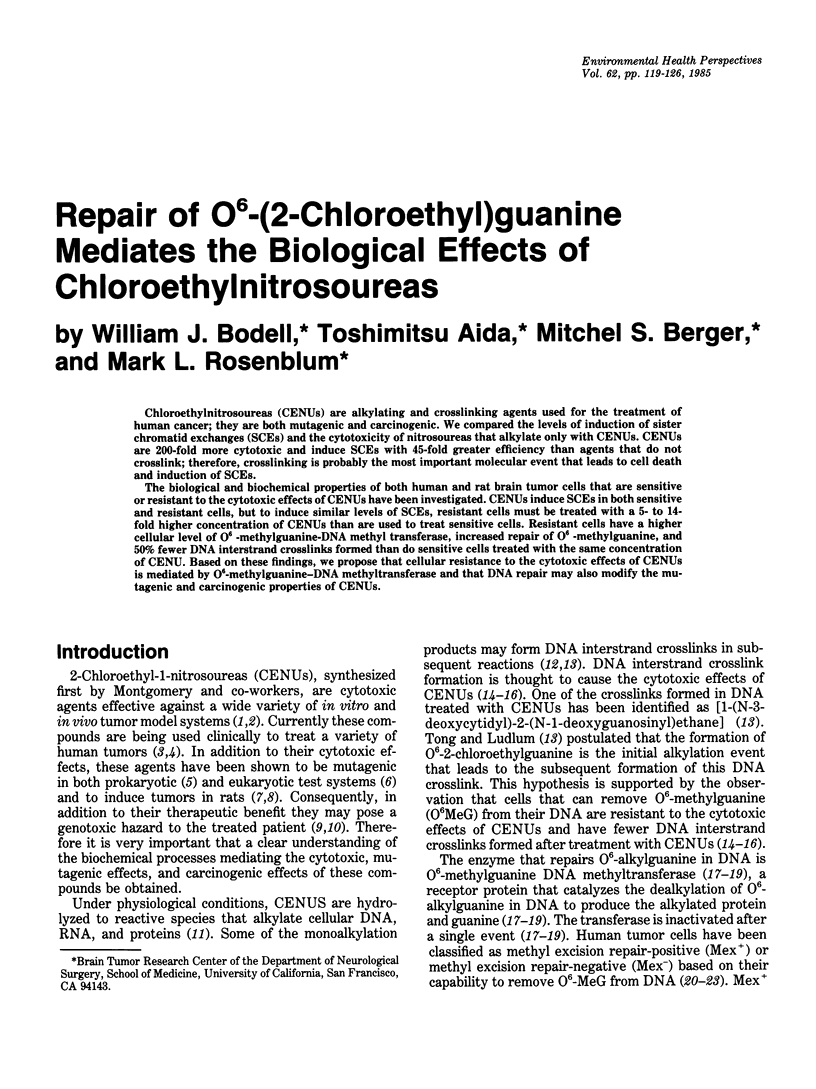
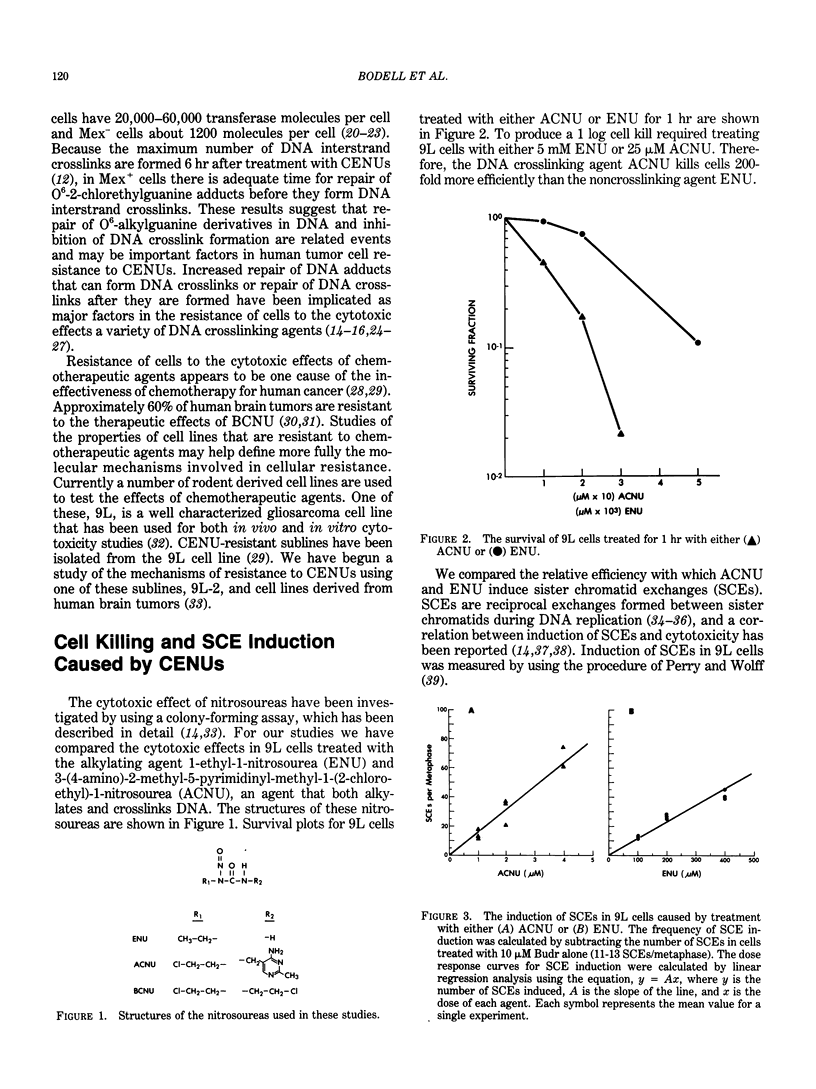
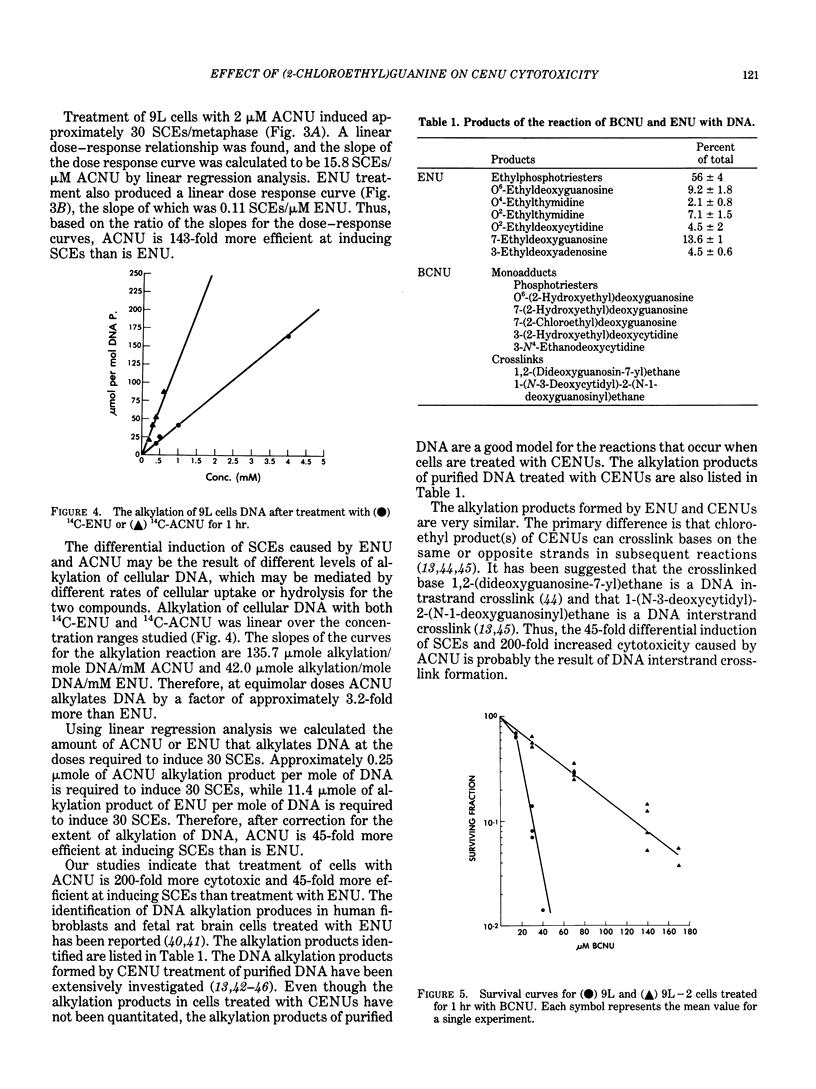

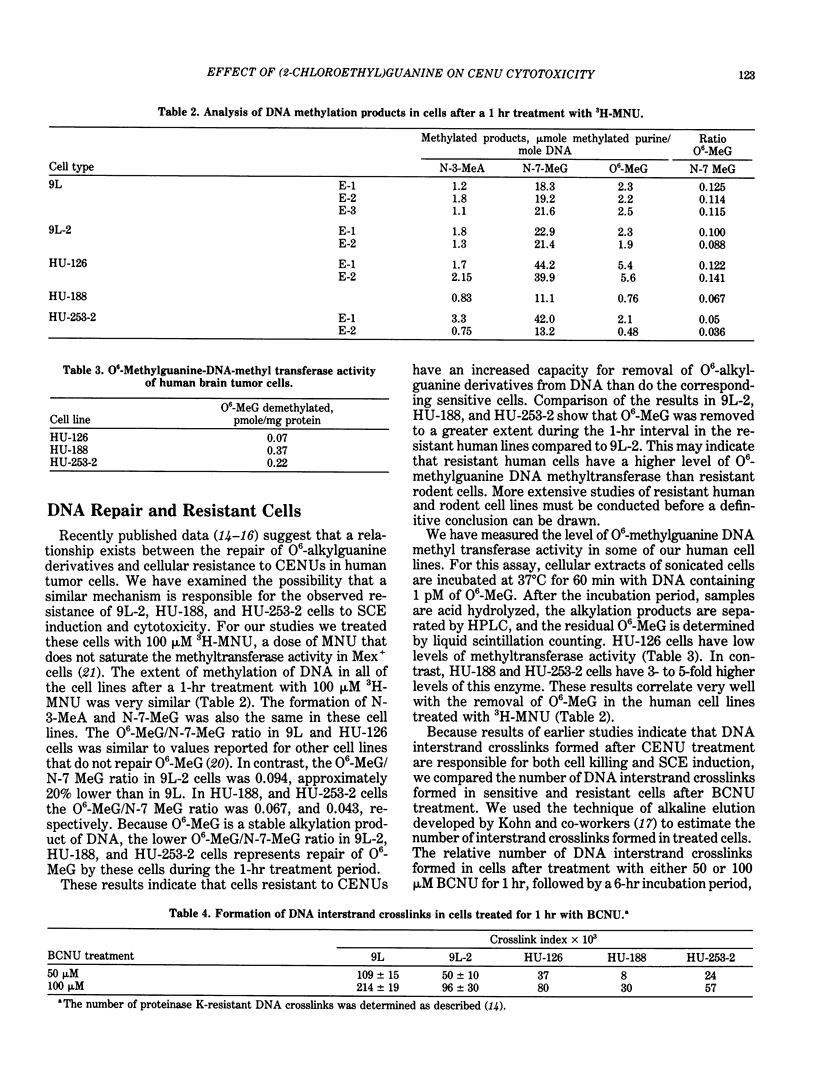
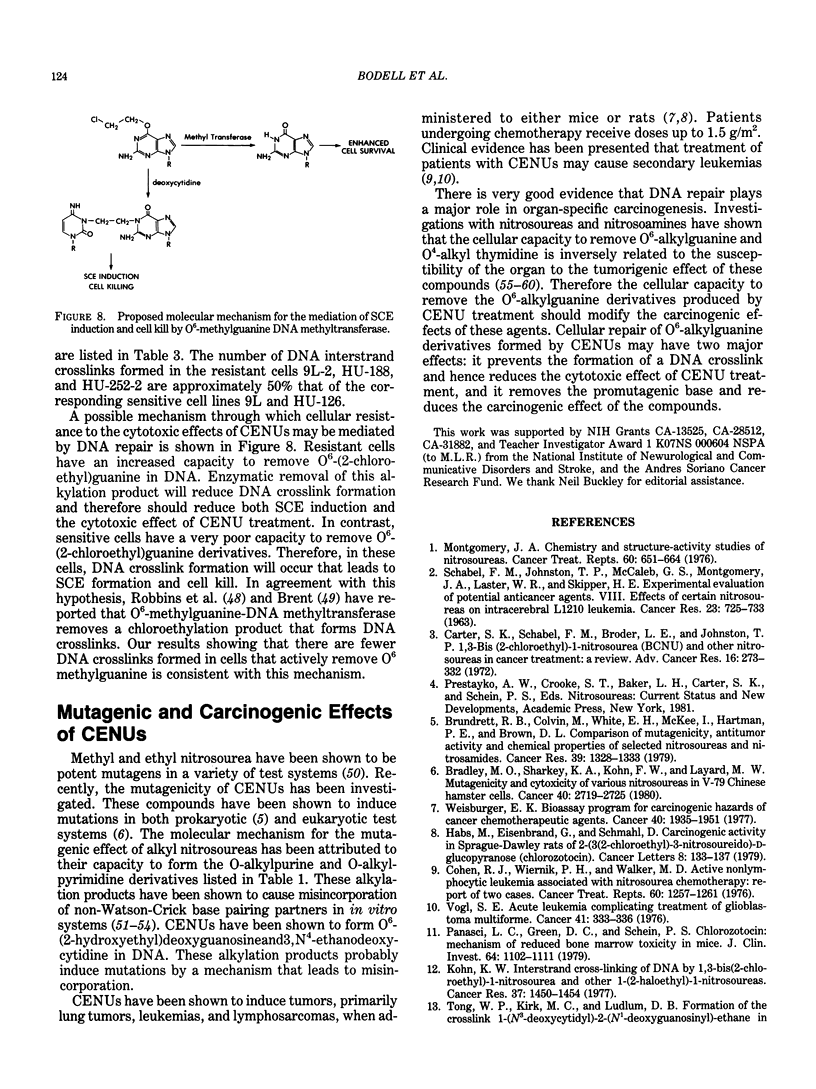
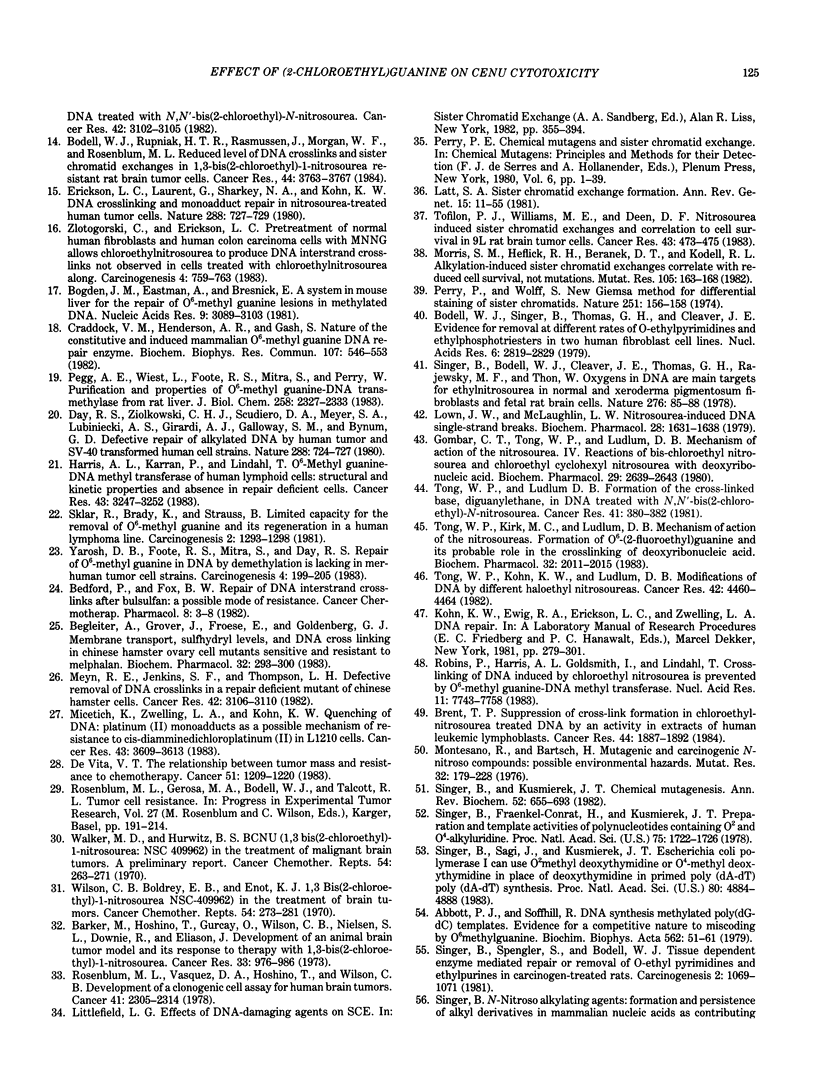
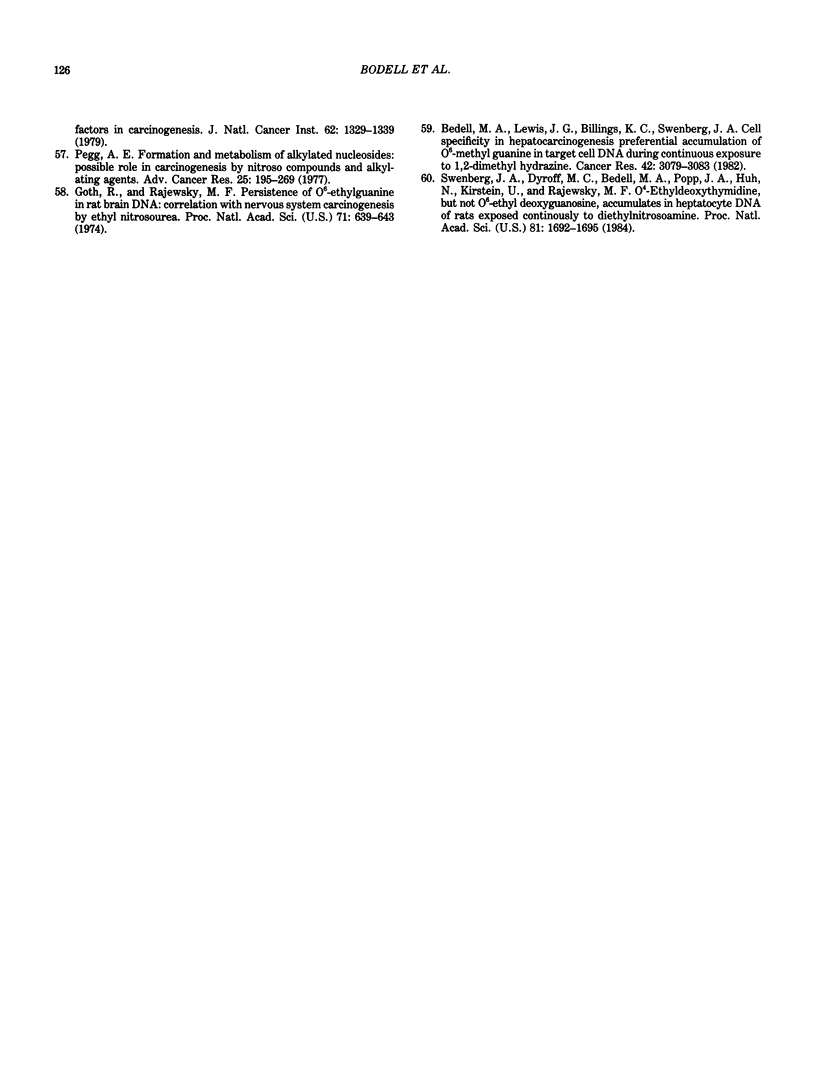
Selected References
These references are in PubMed. This may not be the complete list of references from this article.
- Abbott P. J., Saffhill R. DNA synthesis with methylated poly(dC-dG) templates. Evidence for a competitive nature to miscoding by O(6)-methylguanine. Biochim Biophys Acta. 1979 Mar 28;562(1):51–61. doi: 10.1016/0005-2787(79)90125-4. [DOI] [PubMed] [Google Scholar]
- Barker M., Hoshino T., Gurcay O., Wilson C. B., Nielsen S. L., Downie R., Eliason J. Development of an animal brain tumor model and its response to therapy with 1,3-bis(2-chloroethyl)-1-nitrosourea. Cancer Res. 1973 May;33(5):976–986. [PubMed] [Google Scholar]
- Bedell M. A., Lewis J. G., Billings K. C., Swenberg J. A. Cell specificity in hepatocarcinogenesis: preferential accumulation of O6-methylguanine in target cell DNA during continuous exposure to rats to 1,2-dimethylhydrazine. Cancer Res. 1982 Aug;42(8):3079–3083. [PubMed] [Google Scholar]
- Begleiter A., Grover J., Froese E., Goldenberg G. J. Membrane transport, sulfhydryl levels and DNA cross-linking in Chinese hamster ovary cell mutants sensitive and resistant to melphalan. Biochem Pharmacol. 1983 Jan 15;32(2):293–300. doi: 10.1016/0006-2952(83)90558-0. [DOI] [PubMed] [Google Scholar]
- Bodell W. J., Rupniak H. T., Rasmussen J., Morgan W. F., Rosenblum M. L. Reduced level of DNA cross-links and sister chromatid exchanges in 1,3-bis(2-chloroethyl)-1-nitrosourea-resistant rat brain tumor cells. Cancer Res. 1984 Sep;44(9):3763–3767. [PubMed] [Google Scholar]
- Bodell W. J., Singer B., Thomas G. H., Cleaver J. E. Evidence for removal at different rates of O-ethyl pyrimidines and ethylphosphotriesters in two human fibroblast cell lines. Nucleic Acids Res. 1979 Jun 25;6(8):2819–2829. doi: 10.1093/nar/6.8.2819. [DOI] [PMC free article] [PubMed] [Google Scholar]
- Bogden J. M., Eastman A., Bresnick E. A system in mouse liver for the repair of O6-methylguanine lesions in methylated DNA. Nucleic Acids Res. 1981 Jul 10;9(13):3089–3103. doi: 10.1093/nar/9.13.3089. [DOI] [PMC free article] [PubMed] [Google Scholar]
- Bradley M. O., Sharkey N. A., Kohn K. W., Layard M. W. Mutagenicity and cytotoxicity of various nitrosoureas in V-79 Chinese hamster cells. Cancer Res. 1980 Aug;40(8 Pt 1):2719–2725. [PubMed] [Google Scholar]
- Brent T. P. Suppression of cross-link formation in chloroethylnitrosourea-treated DNA by an activity in extracts of human leukemic lymphoblasts. Cancer Res. 1984 May;44(5):1887–1892. [PubMed] [Google Scholar]
- Brundrett R. B., Colvin M., White E. H., McKee J., Hartman P. E., Brown D. L. Comparison of mutagenicity, antitumor activity, and chemical properties of selected nitrosoureas and nitrosoamides. Cancer Res. 1979 Apr;39(4):1328–1333. [PubMed] [Google Scholar]
- Carter S. K., Schabel F. M., Jr, Broder L. E., Johnston T. P. 1,3-bis(2-chloroethyl)-1-nitrosourea (bcnu) and other nitrosoureas in cancer treatment: a review. Adv Cancer Res. 1972;16:273–332. doi: 10.1016/s0065-230x(08)60343-7. [DOI] [PubMed] [Google Scholar]
- Cohen R. J., Wiernik P. H., Walker M. D. Acute nonlymphocytic leukemia associated with nitrosourea chemotherapy: report of two cases. Cancer Treat Rep. 1976 Sep;60(9):1257–1261. [PubMed] [Google Scholar]
- Craddock V. M., Henderson A. R., Gash S. Nature of the constitutive and induced mammalian O6-methylguanine DNA repair enzyme. Biochem Biophys Res Commun. 1982 Jul 30;107(2):546–553. doi: 10.1016/0006-291x(82)91526-1. [DOI] [PubMed] [Google Scholar]
- Day R. S., 3rd, Ziolkowski C. H., Scudiero D. A., Meyer S. A., Lubiniecki A. S., Girardi A. J., Galloway S. M., Bynum G. D. Defective repair of alkylated DNA by human tumour and SV40-transformed human cell strains. Nature. 1980 Dec 25;288(5792):724–727. doi: 10.1038/288724a0. [DOI] [PubMed] [Google Scholar]
- DeVita V. T., Jr The James Ewing lecture. The relationship between tumor mass and resistance to chemotherapy. Implications for surgical adjuvant treatment of cancer. Cancer. 1983 Apr 1;51(7):1209–1220. doi: 10.1002/1097-0142(19830401)51:7<1209::aid-cncr2820510707>3.0.co;2-j. [DOI] [PubMed] [Google Scholar]
- Erickson L. C., Laurent G., Sharkey N. A., Kohn K. W. DNA cross-linking and monoadduct repair in nitrosourea-treated human tumour cells. Nature. 1980 Dec 25;288(5792):727–729. doi: 10.1038/288727a0. [DOI] [PubMed] [Google Scholar]
- Gombar C. T., Tong W. P., Ludlum D. B. Mechanism of action of the nitrosoureas--IV. Reactions of bis-chloroethyl nitrosourea and chloroethyl cyclohexyl nitrosourea with deoxyribonucleic acid. Biochem Pharmacol. 1980 Oct 1;29(19):2639–2643. doi: 10.1016/0006-2952(80)90079-9. [DOI] [PubMed] [Google Scholar]
- Goth R., Rajewsky M. F. Persistence of O6-ethylguanine in rat-brain DNA: correlation with nervous system-specific carcinogenesis by ethylnitrosourea. Proc Natl Acad Sci U S A. 1974 Mar;71(3):639–643. doi: 10.1073/pnas.71.3.639. [DOI] [PMC free article] [PubMed] [Google Scholar]
- Habs M., Eisenbrand G., Schmähl D. Carcinogenic activity in Sprague-Dawley rats of 2-[3-(2-chloroethyl)-3-nitrosoureido]-D-gluco-pyranose (chlorozotocin). Cancer Lett. 1979 Dec;8(2):133–137. doi: 10.1016/0304-3835(79)90006-5. [DOI] [PubMed] [Google Scholar]
- Harris A. L., Karran P., Lindahl T. O6-Methylguanine-DNA methyltransferase of human lymphoid cells: structural and kinetic properties and absence in repair-deficient cells. Cancer Res. 1983 Jul;43(7):3247–3252. [PubMed] [Google Scholar]
- Kohn K. W. Interstrand cross-linking of DNA by 1,3-bis(2-chloroethyl)-1-nitrosourea and other 1-(2-haloethyl)-1-nitrosoureas. Cancer Res. 1977 May;37(5):1450–1454. [PubMed] [Google Scholar]
- Latt S. A. Sister chromatid exchange formation. Annu Rev Genet. 1981;15:11–55. doi: 10.1146/annurev.ge.15.120181.000303. [DOI] [PubMed] [Google Scholar]
- Lown J. W., McLaughlin L. W. Nitrosourea-induced DNA single-strand breaks. Biochem Pharmacol. 1979 May 15;28(10):1631–1638. doi: 10.1016/0006-2952(79)90176-x. [DOI] [PubMed] [Google Scholar]
- Meyn R. E., Jenkins S. F., Thompson L. H. Defective removal of DNA cross-links in a repair-deficient mutant of Chinese hamster cells. Cancer Res. 1982 Aug;42(8):3106–3110. [PubMed] [Google Scholar]
- Micetich K., Zwelling L. A., Kohn K. W. Quenching of DNA:platinum(II) monoadducts as a possible mechanism of resistance to cis-diamminedichloroplatinum(II) in L1210 cells. Cancer Res. 1983 Aug;43(8):3609–3613. [PubMed] [Google Scholar]
- Montesano R., Bartsch H. Mutagenic and carcinogenic N-nitroso compounds: possible environmental hazards. Mutat Res. 1976;32(3-4):179–228. doi: 10.1016/0165-1110(76)90001-4. [DOI] [PubMed] [Google Scholar]
- Montgomery J. A. Chemistry and structure-activity studies of the nitrosoureas. Cancer Treat Rep. 1976 Jun;60(6):651–664. [PubMed] [Google Scholar]
- Morris S. M., Heflich R. H., Beranek D. T., Kodell R. L. Alkylation-induced sister-chromatid exchanges correlate with reduced cell survival, not mutations. Mutat Res. 1982 Sep;105(3):163–168. doi: 10.1016/0165-7992(82)90006-9. [DOI] [PubMed] [Google Scholar]
- Panasci L. C., Green D., Schein P. S. Chlorozotocin. Mechanism of reduced bone marrow toxicity in mice. J Clin Invest. 1979 Oct;64(4):1103–1111. doi: 10.1172/JCI109549. [DOI] [PMC free article] [PubMed] [Google Scholar]
- Pegg A. E. Formation and metabolism of alkylated nucleosides: possible role in carcinogenesis by nitroso compounds and alkylating agents. Adv Cancer Res. 1977;25:195–269. doi: 10.1016/s0065-230x(08)60635-1. [DOI] [PubMed] [Google Scholar]
- Pegg A. E., Wiest L., Foote R. S., Mitra S., Perry W. Purification and properties of O6-methylguanine-DNA transmethylase from rat liver. J Biol Chem. 1983 Feb 25;258(4):2327–2333. [PubMed] [Google Scholar]
- Perry P., Wolff S. New Giemsa method for the differential staining of sister chromatids. Nature. 1974 Sep 13;251(5471):156–158. doi: 10.1038/251156a0. [DOI] [PubMed] [Google Scholar]
- Robins P., Harris A. L., Goldsmith I., Lindahl T. Cross-linking of DNA induced by chloroethylnitrosourea is presented by O6-methylguanine-DNA methyltransferase. Nucleic Acids Res. 1983 Nov 25;11(22):7743–7758. doi: 10.1093/nar/11.22.7743. [DOI] [PMC free article] [PubMed] [Google Scholar]
- Rosenblum M. L., Vasquez D. A., Hoshino T., Wilson C. B. Development of a clonogenic cell assay for human brain tumors. Cancer. 1978 Jun;41(6):2305–2314. doi: 10.1002/1097-0142(197806)41:6<2305::aid-cncr2820410632>3.0.co;2-u. [DOI] [PubMed] [Google Scholar]
- SCHABEL F. M., Jr, JOHNSTON T. P., McCALEB G. S., MONTGOMERY J. A., LASTER W. R., SKIPPER H. E. Experimental evaluation of potential anticancer agents VIII. Effects of certain nitrosoureas on intracerebral L1210 leukemia. Cancer Res. 1963 Jun;23:725–733. [PubMed] [Google Scholar]
- Singer B., Bodell W. J., Cleaver J. E., Thomas G. H., Rajewsky M. F., Thon W. Oxygens in DNA are main targets for ethylnitrosourea in normal and xeroderma pigmentosum fibroblasts and fetal rat brain cells. Nature. 1978 Nov 2;276(5683):85–88. doi: 10.1038/276085a0. [DOI] [PubMed] [Google Scholar]
- Singer B., Fraenkel-Conrat H., Kuśmierek J. T. Preparation and template activities of polynucleotides containing O2- and O4-alkyluridine. Proc Natl Acad Sci U S A. 1978 Apr;75(4):1722–1726. doi: 10.1073/pnas.75.4.1722. [DOI] [PMC free article] [PubMed] [Google Scholar]
- Singer B. N-nitroso alkylating agents: formation and persistence of alkyl derivatives in mammalian nucleic acids as contributing factors in carcinogenesis. J Natl Cancer Inst. 1979 Jun;62(6):1329–1339. [PubMed] [Google Scholar]
- Singer B., Spengler S., Bodell W. J. Tissue-dependent enzyme-mediated repair or removal of O-ethyl pyrimidines and ethyl purines in carcinogen-treated rats. Carcinogenesis. 1981;2(10):1069–1073. doi: 10.1093/carcin/2.10.1069. [DOI] [PubMed] [Google Scholar]
- Singer B., Sági J., Kuśmierek J. T. Escherichia coli polymerase I can use O2-methyldeoxythymidine or O4-methyldeoxythymidine in place of deoxythymidine in primed poly(dA-dT).poly(dA-dT) synthesis. Proc Natl Acad Sci U S A. 1983 Aug;80(16):4884–4888. doi: 10.1073/pnas.80.16.4884. [DOI] [PMC free article] [PubMed] [Google Scholar]
- Sklar R., Brady K., Strauss B. Limited capacity for the removal of O6-methylguanine and its regeneration in a human lymphoma line. Carcinogenesis. 1981;2(12):1293–1298. doi: 10.1093/carcin/2.12.1293. [DOI] [PubMed] [Google Scholar]
- Swenberg J. A., Dyroff M. C., Bedell M. A., Popp J. A., Huh N., Kirstein U., Rajewsky M. F. O4-ethyldeoxythymidine, but not O6-ethyldeoxyguanosine, accumulates in hepatocyte DNA of rats exposed continuously to diethylnitrosamine. Proc Natl Acad Sci U S A. 1984 Mar;81(6):1692–1695. doi: 10.1073/pnas.81.6.1692. [DOI] [PMC free article] [PubMed] [Google Scholar]
- Tofilon P. J., Williams M. E., Deen D. F. Nitrosourea-induced sister chromatid exchanges and correlation to cell survival in 9L rat brain tumor cells. Cancer Res. 1983 Feb;43(2):473–475. [PubMed] [Google Scholar]
- Tong W. P., Kirk M. C., Ludlum D. B. Formation of the cross-link 1-[N3-deoxycytidyl),2-[N1-deoxyguanosinyl]ethane in DNA treated with N,N'-bis(2-chloroethyl)-N-nitrosourea. Cancer Res. 1982 Aug;42(8):3102–3105. [PubMed] [Google Scholar]
- Tong W. P., Kirk M. C., Ludlum D. B. Mechanism of action of the nitrosoureas--V. Formation of O6-(2-fluoroethyl)guanine and its probable role in the crosslinking of deoxyribonucleic acid. Biochem Pharmacol. 1983 Jul 1;32(13):2011–2015. doi: 10.1016/0006-2952(83)90420-3. [DOI] [PubMed] [Google Scholar]
- Tong W. P., Kohn K. W., Ludlum D. B. Modifications of DNA by different haloethylnitrosoureas. Cancer Res. 1982 Nov;42(11):4460–4464. [PubMed] [Google Scholar]
- Tong W. P., Ludlum D. B. Formation of the cross-linked base, diguanylethane, in DNA treated with N,N'-bis(2-chloroethyl)-N-nitrosourea. Cancer Res. 1981 Feb;41(2):380–382. [PubMed] [Google Scholar]
- Vogl S. E. Acute leukemia complicating treatment of glioblastoma multiforme. Cancer. 1978 Jan;41(1):333–336. doi: 10.1002/1097-0142(197801)41:1<333::aid-cncr2820410144>3.0.co;2-7. [DOI] [PubMed] [Google Scholar]
- Walker M. D., Hurwitz B. S. BCNU (1,3-bis(2-chloroethyl)-1-nitrosourea; NSC-409962) in the treatment of malignant brain tumor--a preliminary report. Cancer Chemother Rep. 1970 Aug;54(4):263–271. [PubMed] [Google Scholar]
- Weisburger E. K. Bioassay program for carcinogenic hazards of cancer chemotherapeutic agents. Cancer. 1977 Oct;40(4 Suppl):1935–1949. doi: 10.1002/1097-0142(197710)40:4+<1935::aid-cncr2820400827>3.0.co;2-r. [DOI] [PubMed] [Google Scholar]
- Wilson C. B., Boldrey E. B., Enot K. J. 1,3-bis (2-chloroethyl)-1-nitrosourea (NSC-409962) in the treatment of brain tumors. Cancer Chemother Rep. 1970 Aug;54(4):273–281. [PubMed] [Google Scholar]
- Yarosh D. B., Foote R. S., Mitra S., Day R. S., 3rd Repair of O6-methylguanine in DNA by demethylation is lacking in Mer- human tumor cell strains. Carcinogenesis. 1983;4(2):199–205. doi: 10.1093/carcin/4.2.199. [DOI] [PubMed] [Google Scholar]
- Zlotogorski C., Erickson L. C. Pretreatment of normal human fibroblasts and human colon carcinoma cells with MNNG allows chloroethylnitrosourea to produce DNA interstrand crosslinks not observed in cells treated with chloroethylnitrosourea alone. Carcinogenesis. 1983;4(6):759–763. doi: 10.1093/carcin/4.6.759. [DOI] [PubMed] [Google Scholar]


